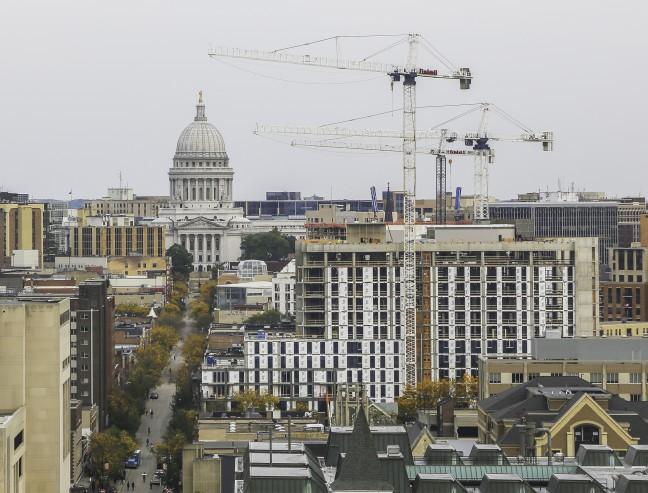Unless you’ve been living under an actual rock, you’ve noticed that Madison’s skyline is littered with cranes. New construction continues across the Isthmus as developers seek entry to an under-tapped market: individuals who want to live downtown outside of traditional student housing. Unlike many students, I think new high-rise apartments are a good thing for the campus community and Madison as a whole.
Though it may seem like it sometimes, our city is not populated entirely by students. Long-time residents intermingle with government employees, young professionals and visitors from across the globe. While it seems intuitive that building for these (financially stable) groups only increases prices for student housing, students and the university itself will be helped by increasing the number of downtown housing options.
Madison has an abnormally low vacancy rate with less than 3 percent of apartments available for lease. In the 53703 zip code where many students live, there are 289 open apartments out of nearly 12,000 available. With lakes on each side, the only way to reduce the vacancy rate is to either raise rents to (even more) prohibitive levels or build upwards. I am glad Madison is opting for the second strategy, even if it comes at the expense of some “neighborhood character.” I know that some love the three-story house look of the Mifflin area, but apartments that size are not sustainable. As a simple matter of supply and demand, vacancy rates must increase for rents to decrease. In the Mifflin area and throughout downtown, building upwards will help push rent downwards. Students should support more, not fewer, apartments downtown in order to reduce prices.
Besides the economic argument for increasing the supply of apartments, the construction of new high-rise buildings fosters a vibrant downtown community. A nearby population of students, young professionals and long-time community members is vital to bringing creative, productive and tax-paying new businesses and activities to the Isthmus. There will be new bars, new restaurants, new activities, new attractions and new shopping locations once there is an additional market to support it. Past experience verifies this. Construction of the Lucky building brought with it new businesses that the campus area previously lacked — including a grocery store accessible to more students than is Capital Center. Madison Fresh Market has been phenomenally successful in an area that previously verged on being a food desert. Fresh Market and the numerous other stores that occupy the first floor of the Lucky complex add jobs for students and professionals and drive increased foot traffic through the area.
In addition to the increased business and activities available for students, new, large apartment complexes help drive new talent to the Madison area. People visiting a city judge it by its cover. Prospective students visit Madison daily and have only a short time to determine if this is where they want to spend their college years. Beautiful mixed use buildings make the city appear growing and vibrant. The university does this with new dormitories. The Witte and Sellery Halls of the world are disappearing in favor of the Ogg and Dejope style dormitories featuring modern designs and multi-use facilities. Prospective students find that they have many housing options both on and off campus.
In a similar way, young professionals who come to Madison to interview with local businesses are often put up in one of the nicer downtown hotels. Part of the experience for many of these interviewees is visiting State Street at night or having a few drinks around the Square. When I started at Epic, all of those who started at the same time in my area lived out by Verona to be close to work. Now, two years later, everyone lives downtown in order to be closer to the nightlife and opportunities that the downtown area offers. Epic is commonly cited as a reason for the additional apartments being built downtown, and while it is not the only factor driving growth downtown, Epic employs more than 7,000 young graduates who want to live in a fun, active community without saving quarters for the communal laundry machine.
Worrying that affordable housing will disappear is a valid concern, but stopping future construction will not fix that. Right now, low vacancy rates suggest that there is additional demand for apartments, and developers are eager to supply them. There will always be a market for lower-priced housing, just as there will be a market for higher-priced housing. By offering additional housing options, prices will ultimately decline overall. While you may never get into The Hub — opening August 2015 – for less than $500 per bedroom, other options will exist.
As with most things in life, if you don’t want to live in a luxury high rise, no one is forcing you to. However, many do want to live downtown in newer, nicer complexes, and I am glad these options will exist. Students should embrace their new neighbors and focus on how to work together to make the downtown the best it can be, for everyone.
Adam Johnson (amjohnson25@wisc.edu) is a graduate student at the La Follette School of Public Affairs.


